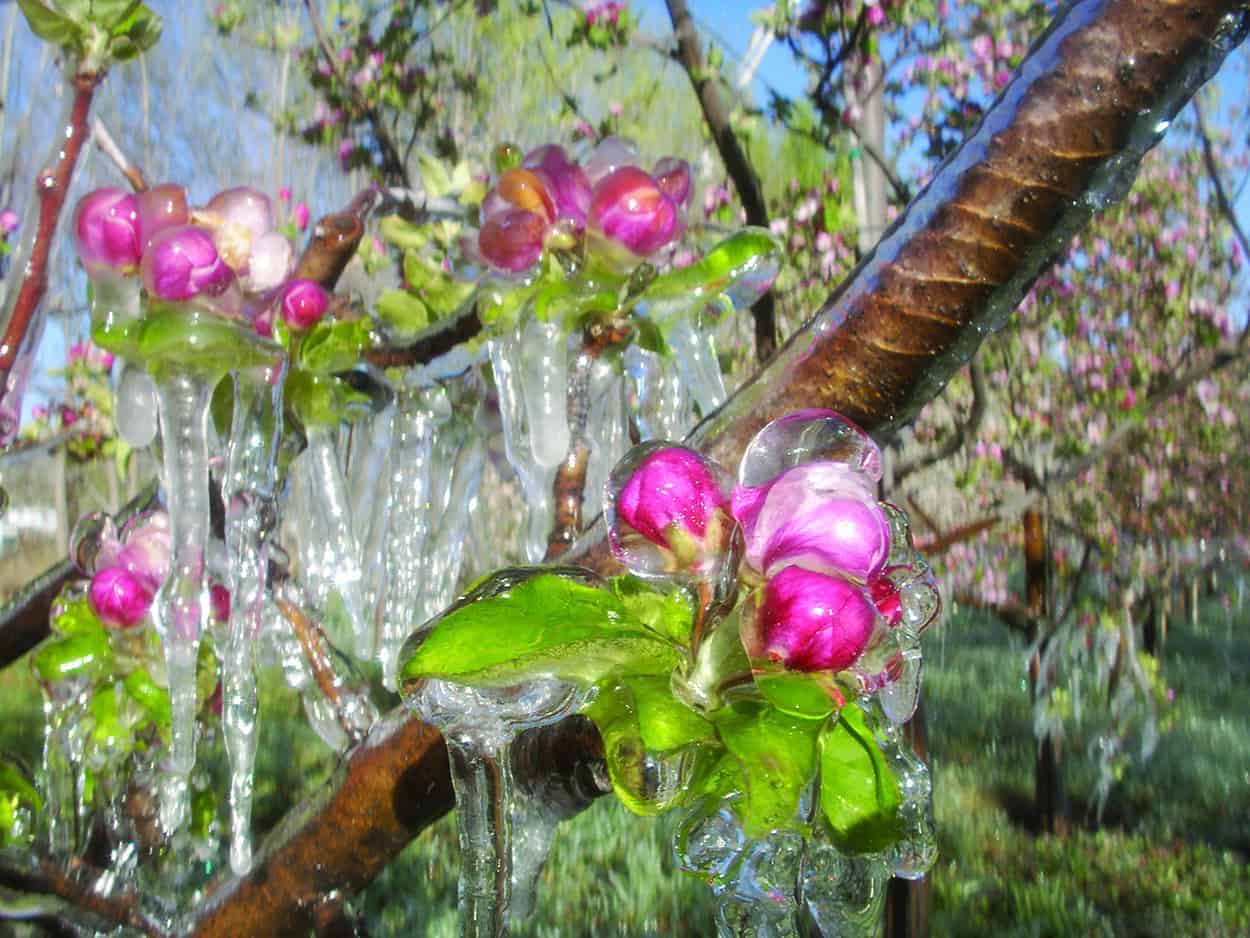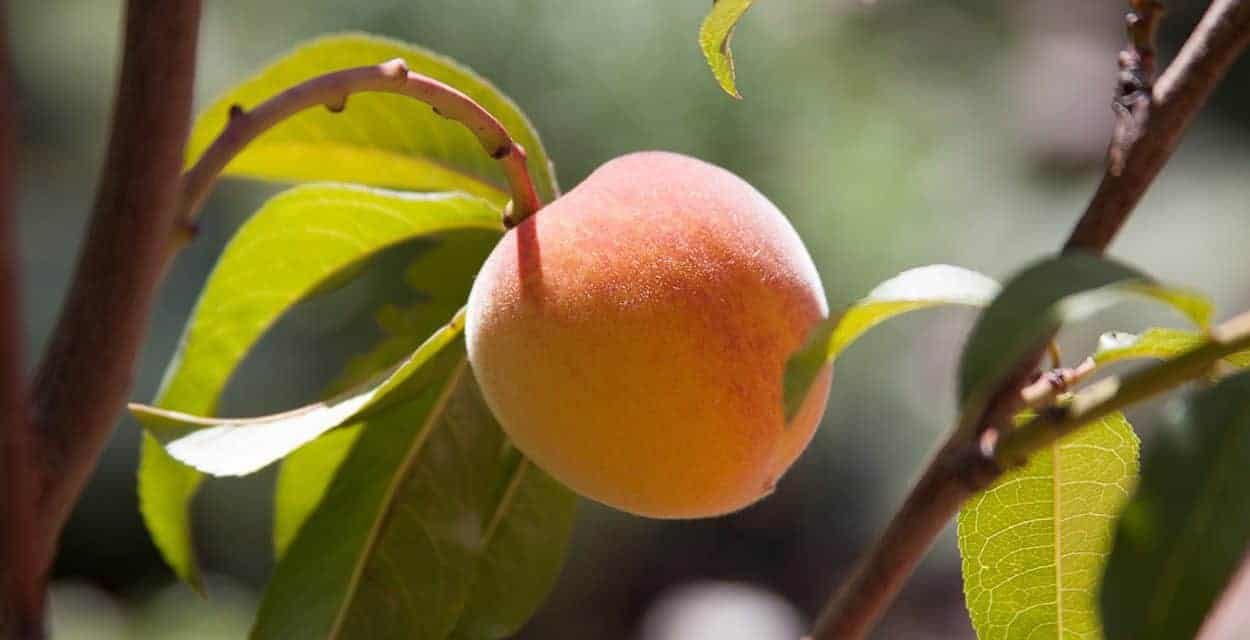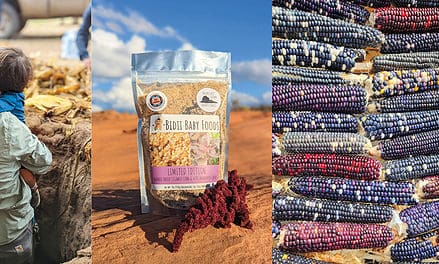
By Mark DeRespinis
On a cloudy afternoon in early June, I visited Freshies Farm in Lyden, on the stretch of the Rio Grande just south of Velarde, to meet with owners Christopher and Taylor Bassett. We stood alongside rows of closely-ranked, v-shaped peach trees in full leaf, beholding a bountiful crop of downy green adolescent peaches. “This is our third full crop of peaches in eight years of running the farm,” Christopher said frankly, though with a gleam of delight in his eye. It was shaping up to be a really good year.
By all accounts, raising an orchard in the northern mountains is a risky business. In the spring, warm spells coax dormant buds into bloom while nighttime temperatures still dip below freezing. Timing is everything, and orchardists are fanatical about the specifics of their zone and the patterns of the weather during bloom. A dip below twenty-eight degrees can devastate tender flowers. The precarious odds play out again and again, from valley bottom to mountain hillside: a good crop comes one in every three years for apples; one in every five years for peaches; and one in every ten years for apricots. Despite these challenges, in the middle of the last century, the Española Valley gained renown as one of the fruit baskets of the Southwest; every day, during harvest season, truck- and trainloads of fruit left for cities near and far.
Christopher described the scene at Freshies during the peach bloom just two months earlier, when an Easter-time cold spell descended and killed off most of the stone fruit in the area. For times like these, when the orchard is most sensitive, the Bassetts have a dual strategy for protecting their precious flowers from the brutal extremes of mountain weather. A temperature sensor in the orchard sets off an alarm that could wake the dead, and the farmers spring into action. A forty-foot tall wind machine circulates warm air in the vicinity and keeps the cold from settling in among the trees. Meanwhile, a micro-sprinkler irrigation system coats the orchard in a thick layer of ice, protecting the buds and flowers until the sun comes out and warms the air, lifting the temperature out of the danger zone. Following the long orcharding tradition of the valley, these small farmers are finding ways to use technological innovations to their advantage as they attempt to rebuild local and regional markets and return quality artisanal production to their communities. Using these strategies, Freshies Farm has succeeded in bringing (at least some, and often many) peaches to market in all but two of the last eight years. And their apples, protected by the same systems, have been even more consistent.
The Bassetts took over this state-of-the-art orchard in 2008. The former owner, Walter Lee of Cottonwood Lane Orchards, had installed the orchard system eight years earlier, with the help of NMSU fruit specialist, Dr. Ron Walser. At the time, the orchard contained an acre of mature certified organic apple trees, an acre of mature certified organic peach trees, the irrigation system and wind machine, a row of Triple Crown blackberries, and several hundred feet of dike-side river frontage cottonwood bosque shade. Living in an old Airstream, they began working the orchard, building a home, and developing the farm’s infrastructure. Freshies showed up at the Santa Fe Farmers Market in 2010 and has been a mainstay there ever since. “We don’t grow a lot of crops,” Christopher said. “We grow six crops and we aim to grow a lot of them at the highest quality and at full flavor. Tree-ripened, vine-ripened, peak of flavor, ready for eating right now.”
The Bassetts started with apples, peaches, and blackberries. In 2011, they lost their peach crop to a winter deep freeze that killed the buds on the trees before they even bloomed. Fortuitously, they had applied for a high tunnel grant from the Natural Resources Conservation Service that winter and were able to construct it and begin growing tomatoes and cucumbers. The same year, they started growing oyster mushrooms, taking over Desert Fungi from Danny Rhoads and assimilating it into their production schedule. After another lost peach crop in 2013, they expanded their oyster mushroom production and have since been supplying two hundred pounds a week to farmers market customers and local chefs. That year, they also experimented with a high-density cherry tree planting and found space on the edges of the mature orchard to do a pluot planting. They fit these expansions within their available land by reclaiming a driveway through the orchards for the high tunnel and tucking the mushroom house away in a shady cottonwood grove behind their chicken coop. This efficient use of the available growing space, high-density planting, and use of protected space to create ideal conditions for certain crops have all helped Freshies chart the way forward for fruit production in northern New Mexico.
We toured the peach and apple orchards, peeked inside the mushroom shade house, and observed melons and Sungold tomatoes just beginning to climb their trellis in the high tunnel. The new land and its recent plantings beckoned, so we hopped in the car and drove about a mile down the road before the tunnel structure loomed into view, catching the mesa’s warm evening light on its patterned geometries. It is truly a majestic sight, a kind of temple of modern agriculture. Five adjacent tunnels, measuring thirty-feet by three-hundred-feet each, contain seemingly endless rows of fruit trees, with tomatoes and cucumbers planted in between.
The rows are not, in fact, endless, and, as Christopher explained, in their new acre of high-tunnel fruit production, the Bassetts planted according to the advice of leading fruit tree experts on planting orchards at high density to increase yield and speed up production. “There is a finite amount of irrigated land in New Mexico, a really low percentage—increasing the productivity of that land is what’s going to help us feed ourselves.”
The trees stand in close and orderly ranks—three feet apart and trained to a series of trellis wires that promise to hold them as they climb towards the sky. Freshies just planted these trees in April and already they sported a healthy coat of leaves and new growth. The Bassetts have decided to focus on stone fruits in their high-tunnel orchard expansion, and Christopher excitedly detailed the varieties of apricots, plums, sweet cherries, and nectarines they have planted to enable the longest possible harvest window for each fruit. A core principle of the Freshies planting program is to provide the most delicious and ripe fruit for the longest possible season, using varieties that mature at different times. With the protection of the tunnels, Freshies will have a reliable crop of these precious summer fruits to sell throughout the region, adding an array of exciting new items to the menu of seasonal delicacies that enrich the lives of local food lovers.
As we walked down the long rows, Christopher pointed to tomato and cucumber plants that would bear fruit in the next couple weeks, including their much-coveted Sungold tomatoes, heirlooms such as Cherokee Purple, and thin-skinned cucumbers. They planted the tomatoes and cucumbers between the orchard rows to make efficient use of the space while the trees are still small and don’t require tractor access for harvest. The experience of being in the tunnels was mesmerizing. I imagined the tomatoes reaching the top trellis wire at ten feet tall and the hedges of trees adorned with fragrant rosy blossoms, later hanging heavy with brightly colored fruits.
We left the tunnels and looked out over an adjacent field planting. As we walked, we passed by recently composted and mulched rows of table grapes; blackberries; and red, black, and yellow raspberries—a bramble and vineyard planting that promised to bear many a berry in the years ahead. These diverse delights complete the roster of fruits that Freshies has planned for farmers market tables, the produce department of La Montañita Co-op, and the kitchens of chefs around the region. “They know when they get something from us, that it’s gonna be the best, and when you taste it, you say: these things are something special.” The future looks good for northern New Mexico locavore fruit lovers—no more waiting ten years for the taste of a ripe apricot fresh off the tree. And perhaps we can look forward to a time when the Española Valley will be revered as the fruit basket of the region once again.
www.freshiesnm.com



Five adjacent tunnels, measuring 30’x300’ each, contain seemingly endless rows of fruit trees, with tomatoes and cucumbers planted in between. These photos attempt to capture the awe-inspiring structure. Photos by Stephanie Cameron.
Photo Gallery
[Best_Wordpress_Gallery id=”2″ gal_title=”Select Gallery”]
Edible celebrates New Mexico's food culture, season by season. We believe that knowing where our food comes from is a powerful thing. With our high-quality, aesthetically pleasing and informative publication, we inspire readers to support and celebrate the growers, producers, chefs, beverage and food artisans, and other food professionals in our community.












